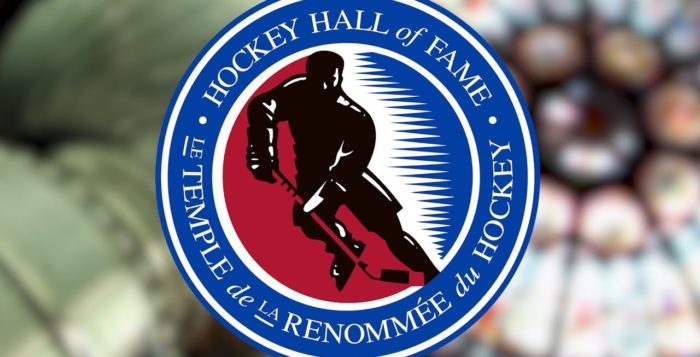This Day in Hockey History – September 8, 1980 – Two Goalies and Two Coaches
Induction into the Hockey Hall of Fame is a great honor. In 1980, the Hall chose two goalies and two men who coached in the American Hockey League (AHL) before moving up from there. At the ceremony held September 8, Gump Worsley, Harry Lumley, Lynn Patrick, and Jack Butterfield were inducted.
Worsley was born in 1929, but he did not break into the NHL until 1952, having played in five different leagues up until that point. He won the Calder Trophy that first season, despite the overall poor showing by his New York Rangers. Oddly, he became the only Calder-winner sent back to the minors for the entire season following his award. Returning to the Rangers, he stayed for the next decade. In 1963, they controversially traded him to the Montreal Canadiens, where he remained seven seasons, winning four championships. Worsley retired in 1969 due to his fear of flying. Being told there wouldn’t be much traveling and that he would receive bonuses based on wins and shutouts, Worsley un-retired, signed with the Minnesota North Stars, and ended up staying four years. As one of the few remaining holdouts, during his last six games, Worsley finally wore a mask.
After 860 games, Worsley had 43 shutouts and a 2.91 goals against average. He was called an “iron goalie.” Despite his long 20-year career, Worsley said at his induction, “I never wanted to leave the sport. I had so many great memories I didn’t want them to stop.”
Born the year after Worsley, at 17 “Apple Cheeks” Lumley was the youngest goalie in the NHL when he backstopped the Detroit Red Wings during World War II. He remained in Detroit through their 1950 Stanley Cup victory, after which they stuck with Terry Sawchuck and traded Lumley to the Chicago Blackhawks. Lumley went back and forth with Chicago and the Toronto Maple Leafs before ending up with the Boston Bruins in 1957 and retiring there in 1960. While with Toronto, Lumley earned the Vezina Trophy in 1953-54. He set a record with his 13 shutouts that stuck until 1970. By the time he was inducted, Lumley was a retired businessman who could “never watch hockey games much anymore” because he would “get too tense.”
As Patrick had died in January, his son Craig accepted the honor on his behalf. Craig would receive his own induction in 2001. Lynn’s father Lester and uncle Frank had already been inducted in 1947 and 1958, respectively. Hardly surprising then that the Patricks have been called “Hockey’s Royal Family.”
As for Lynn Patrick’s worthy career in the NHL, he was actually inducted as a player. After reluctantly (due to nepotism accusations) signing with the New York Rangers (led by his father), he skated with them from 1934 to 1947, winning the Stanley Cup in 1940. After hanging up his skates, Patrick briefly coached the AHL’s New Haven Ramblers before temporarily taking over as the Rangers’ coach. He began coaching the Boston Bruins in 1950 as their GM and then spent the last decade with them just managing. In 1967, Patrick became the St. Louis Blues’ first GM and coach and then became vice president before retiring in 1977.
Butterfield spent six decades working in the AHL, and his start could also be considered nepotism. After breaking his back while serving during World War II, he worked as a trainer with the New Haven Eagles led by his uncle, Eddie Shore. After a few years in other leagues, Butterfield led the AHL’s Springfield Indians as trainer then coach and even general manager. With him as GM, they won three consecutive Calder Cup championships at the beginning of the 1960s.
In 1966, Butterfield took on the role he became best known for and held for a record 28 years, president of the AHL. His successor, David Andrews, said later in eulogy, “The American Hockey League would not exist today were it not for the efforts of Jack Butterfield during his tenure as president. He is a hockey legend and his contributions will forever be honored by the AHL.” He helped the league survive and restructure as the NHL expanded and the WHA came and went. Along those lines, Butterfield revised the league’s constitution and by-laws, and the NHL Rules Committee often asked his opinions.
After his HHOF induction, in 1984, he won his second James C. Hendy Award as outstanding executive. In 1985, Butterfield received the Lester Patrick Award for service to hockey in the U.S. He received the first Thomas Ebright Award for career contributions to the AHL when the award was given in 1998. The AHL finally inducted Butterfield when they began their own Hall of Fame in 2006. In his honor, the Jack A. Butterfield Trophy has been awarded annually since 1984 to the AHL playoff MVP.
Additional Sources:
- “Worsley Inducted,” New York Daily News, 9 Sept. 1980, p. 41.
- Glenn Cole, “Worsley enters Hall of Fame,” Montreal Gazette, 9 Sept. 1980, p. 17.
- “Worsley, Lumley joine Hockey Hall of Fame,” Ottawa Citizen, 9 Sept. 1980, p. 23.
- https://thepinkpuck.com/2019/02/08/this-day-in-hockey-history-february-8-1958-lumley-comes-up-second/
- https://thepinkpuck.com/2018/10/08/this-week-in-hockey-history-october-8-1971-hockeys-royal-family-adds-third-patrick-generation/
- https://theahl.com/ahl-mourns-passing-of-jack-butterfield
- https://theahl.com/jack-butterfield-1919-2010














